OH Reactivity
 The University of Leeds OH Reactivity instrument has been deployed during two field measurement campaigns in the UK (Writtle, near London, and Weybourne) and in the Danum Valley, Borneo. An updated version of the lifetime instrument, based on flash photolysis, is currently under development in preparation for a field measurement campaign in York in May 2014.
The University of Leeds OH Reactivity instrument has been deployed during two field measurement campaigns in the UK (Writtle, near London, and Weybourne) and in the Danum Valley, Borneo. An updated version of the lifetime instrument, based on flash photolysis, is currently under development in preparation for a field measurement campaign in York in May 2014.
ClearfLo: London, 2012
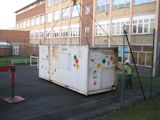
Measurements of OH reactivity were made at a central London site during the Clean Air for London (ClearfLo) project. More details of the project can be found on the Ground-based FAGE fieldwork page.
OP3: Borneo, 2008
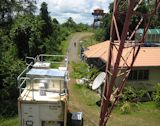
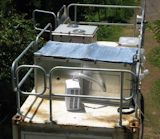
The OH reactivity instrument was used during the Oxidant and Particle Photochemical Process (OP3) fieldwork in the Danum Valley, Borneo. The instrument was positioned in an air-conditioned aluminium case alongside the detection cells of the ground-based FAGE instrument (see Ground-based FAGE) on the roof of the FAGE container. The measurements of total OH reactivity were compared to the results of a modelling study...
References
Edwards, P.M.; Evans, M.J.; Furneaux, K.L.; Hopkins, J.; Ingham, T.; Jones, C.; Lee, J.D.; Lewis, A.C.; Moller, S.J.; Stone, D., Whalley, L.K.; Heard, D.E. OH reactivity in a South East Asian Tropical rainforest during the Oxidant and Particle Photochemical Processes (OP3) Project, Atmospheric Chemistry and Physics, 2013, 13, 9497-9514
Ingham, T.; Goddard, A.; Whalley, L.K.; Furneaux, K.L.; Edwards, P.M.; Seal, C.P.; Self, D.E.; Johnson, G.P.; Read, K.A.; Lee, J.D.; Heard, D.E. A flow-tube based laser-induced fluorescence instrument to measure OH reactivity in the troposphere, Atmospheric Measurement Techniques, 2, 465-477, 2009
TORCH-1: Writtle, near London, 2003
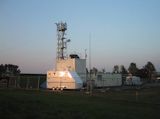

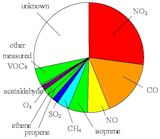
The Tropospheric ORganic CHemistry (TORCH) experiment took place at the rural site of Writtle Agricultural College, 20 miles north-east of Central London and 10 miles north-east of the M25 motorway. With negligible local emissions from Writtle village, this site provided an opportuinity to sample air-masses 1 - 2 hours downwind of London.
During the campaign air masses from south west England, East Anglia, and the Arctic were intercepted. The average OH reactivity was ~ 7.4 s-1. Calculated OH reactivity was consistently lower than that measured value, indicating a large unknown OH sink. The figure to the right shows OH sinks calculated by a campaign-tailored observationally constrained box model.
References
Emmerson K.M.; Carslaw N.; Carslaw, D.C.; Lee J.D.; McFiggans G.; Bloss, W.J.; Gravestock T; Heard D.E.; Hopkins J.; Ingham T.; Pilling M.J.; Smith S.C.; Jacob M.; Monks P.S. Free radical modelling studies during the UK TORCH Campaign in Summer 2003, Atmospheric Chemistry and Physics, 7, 167-181, 2007
Lee, J.D.L.; Lewis, A.C.; Monks, P.S.; Jacob, M.; Hamilton, J.F.; Hopkins, J.R.; Watson, N.; Saxton, J.; Ennis, C.; Carpenter, L.J.; Carslaw, N.; Fleming, Z.L.; Bandy, B.J.; Oram, D.E.; Penkett, S.A.; Slemr, J.; Norton, E.; Rickard, A.R.; Whalley, L.K.; Heard, D.E.; Bloss, W.; Gravestock, T; Smith, S.; Stanton, J.; Pilling, M.J.; Jenkin, M.E.; Bower, K.; Coe, H.; Cryer, D.; Emmerson, K.M.; Gallagher, M.; Ingham, T.; Johnson, D.; Johnson, G.; McFiggans, G.; McQuaid, J.B.; Mills, G.; Seakins, P.W.; Utembe, S.; Vaughan, G. Ozone photochemistry and elevated isoprene during the U.K. heat wave of August 2003, Atmospheric Environment, 40, 7598-7613, 2006
TORCH-2: Weybourne, 2004
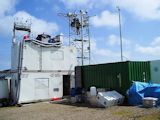
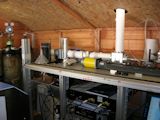
The second TORCH experiment took place a year later and was based at the Weybourne Observatory on the Norfolk coast, several hunderd miles away from London. As with the earlier TORCH project, the focus was on the outflow of emissions from London and subsequent chemical processing. At this location, the aim was to intercept a more aged/processed air-mass.For the most part clean northerly air masses from the North Sea dominated, with air occasionally coming from across the country. The average OH reactivity was ~ 5.3 s-1 reflecting the cleaner air-masses intercepted.
References
Lee, J.D.; Young, J.C.; Read, K.A.; Hamilton, J.F.; Hopkins, J.R.; Lewis, A.C.; Bandy, B.J.; Davey, J.; Edwards, P.; Ingham, T.; Self, D.E.; Smith, S.C.; Pilling, M.J.; Heard, D.E. Measurement and calculation of OH reactivity at a United Kingdom coastal site, Journal of Atmospheric Chemistry, 64 (1), 53-76, 2009
